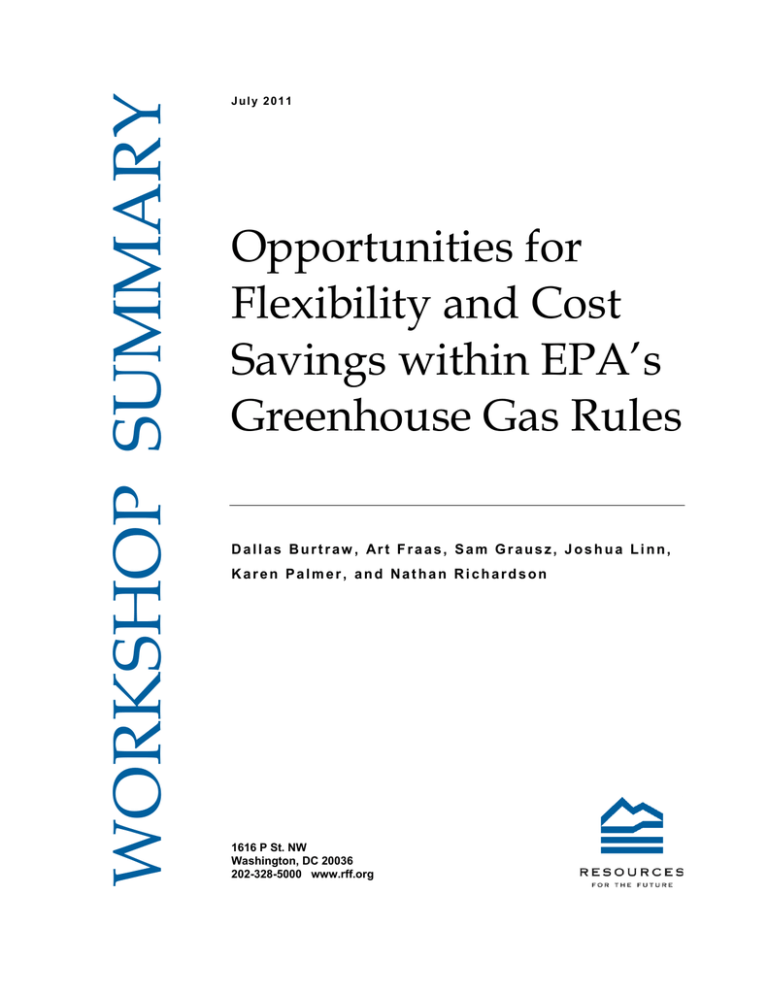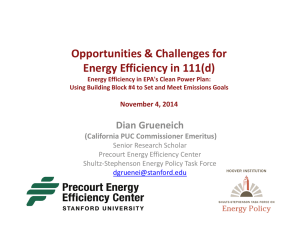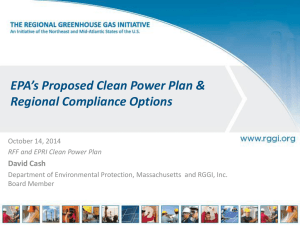ARY SUMM Opportunities for
advertisement

WORKSHOP SUMMARY July 2011 Opportunities for Flexibility and Cost Savings within EPA’s Greenhouse Gas Rules D al l as Burt raw , Ar t F ra as, Sam G r aus z, J os h u a Li nn, Karen Palmer, and Nathan Richardson 1616 P St. NW Washington, DC 20036 202-328-5000 www.rff.org Resources for the Future Burtraw et al. Opportunities for Flexibility and Cost Savings within EPA’s Greenhouse Gas Rules Dallas Burtraw, Art Fraas, Sam Grausz, Joshua Linn, Karen Palmer, and Nathan Richardson Leadership in federal climate policy has passed from Congress to the Environmental Protection Agency (EPA). In 2007 the Supreme Court confirmed the agency‟s authority to regulate greenhouse gases (GHGs) under the Clean Air Act (“the Act”). After a formal scientific finding that these emissions pose a danger to health and welfare, the agency began promulgating regulations to mitigate that harm. In September, the EPA will issue proposed regulations affecting steam boiler electricity generating units and refineries. Those regulations will be finalized in 2012. EPA has indicated its intent to issue regulations for existing sources under Section 111(d) of the Act, which requires EPA to establish guidelines and emissions performance standards and states to develop implementation plans.1 On July 18, Resources for the Future convened a small, structured workshop on the forthcoming GHG regulations with participants from academia, industry, nongovernmental organizations, EPA, and the administration. The workshop was specifically focused on the legal feasibility and economic importance of using flexible compliance mechanisms such as trading of emissions reduction obligations among regulated facilities.2 Opinions expressed at the workshop were not for attribution, and no attempt was made to develop consensus. However, a number of insights emerged. Burtraw is the Darius Gaskins Senior Fellow, Fraas is a Visiting Scholar, Grausz is a Research Assistant, Linn is a Fellow, Palmer is aSenior Fellow, and Richardson is a Resident Scholar. For more information, contact: Dallas Burtraw, burtraw@rff.org; Art Fraas, fraas@rff.org; Josh Linn, linn@rff.org; Karen Palmer, palmer@rff.org; and Nathan Richardson, richardson@rff.org. The workshop focus drew from two recent RFF discussion papers. “Prevailing Academic View on Compliance under §111 of the CAA” (RFF Discussion Paper 11-29), written with collaboration from legal scholars at Columbia and NYU, reviews the scholarly legal literature on the potential for flexibility under the CAA. “Retail Electricity Price Savings from Compliance Flexibility in GHG Standards for Stationary Sources” (RFF Discussion Paper 1130), uses the RFF Haiku electricity sector model to calculate the economic impacts of potential versions of the EPA GHG regulations, comparing policies with and without compliance flexibility. 1 The EPA will issue regulations for new sources under Section 111(b). 2 An example of such flexibility is tradable performance standards as was used in the phase out of lead from gasoline in the 1980s, generally viewed as one of EPA‟s most successful programs. (See RFF Discussion Paper 03-37.) 1 Resources for the Future Burtraw et al. Compliance Flexibility Has Substantial Economic Benefits Workshop participants shared the view that EPA and the states have basic legal authority to allow flexibility in compliance, although alternative rationales were offered to support this position. Some favored a route to flexibility through EPA‟s powers to set performance standards. Others favored an alternative route based on a broad interpretation of state implementation powers. Workshop participants also heard that the benefits of flexible compliance could be substantial. The opportunity to trade emissions reduction obligations within the single category of coal-fired steam electricity boilers reduces the increase in electricity price by 60 percent and overall costs by two-thirds in 2020. A key issue is how an emissions source category is defined, and whether compliance is limited to within a single emissions source category or if trading across source categories also will be allowed. One option is for EPA to create a broad source category encompassing different technologies. Some workshop participants feel this may be a necessary step to allow broad flexibility. Moreover, EPA may revise the category definition in the future. Two Legal Rationales The rationale in support of EPA‟s ability to implement flexibility directly stems from the definition of “standards of performance” in the Act as “the degree of emission limitation achievable through the application of the best system of emission reduction”, taking cost into account. 3 Under this rationale, the definition itself is sufficient to allow flexibility—with the preferred flexible approach characterized as the “best system” based on its ability to achieve cost-effective emissions reductions. It is also possible to point to the textual change in Section 111(d) in the 1990 amendments, which specifically removed the term “technology” from this definition, indicating an intentional shift by Congress away from site-specific, command-andcontrol technology solutions. There was some caution expressed about an overly expansive reading of “standards of performance” that moves too far away from controlling individual sources or an expansive 3 “The term „standard of performance‟ means a standard for emissions of air pollutants which reflects the degree of emission limitation achievable through the application of the best system of emission reduction which (taking into account the cost of achieving such reduction and any nonair quality health and environmental impact and energy requirements) the Administrator determines has been adequately demonstrated.” (CAA 7411(a)(1)) 2 Resources for the Future Burtraw et al. reading of the “best system of emissions reduction” that moves too far away from the technological basis of the Act. The consequence of too much movement in these directions by EPA would be greater political or legal objections. This concern leads some to favor the second rationale that places states in the primary role of introducing flexible options for compliance with the standards. This view holds that the opportunity for compliance flexibility flows from the devolution of authority to states and their role in the development of implementation plans. In this capacity states can implement flexible compliance mechanisms as long as they achieve the federal standards for performance. This view is based on the latitude given by the Act to states to develop flexible emissions reduction mechanisms through the State Implementation Plan (SIP) process under §110, on which the Act explicitly models the process for §111(d) performance standards. Regulatory Structure These two rationales in support of broad authority to pursue compliance flexibility imply somewhat different regulatory structures. The general way forward is the following. Initially EPA will prescribe performance standards and subsequently evaluate state plans to achieve those standards. EPA also is required to establish a federal plan as a backup if state plans are not adequate or timely. The alternative rationales imply in one case that EPA could play an assertive role in building compliance flexibility into the design of the federal plan and invite states to adopt this plan as their state plan. States would remain free to deviate from EPA‟s chosen approach, so long as they could demonstrate equivalent environmental performance. Alternatively, EPA could rely on the states to introduce options for compliance flexibility. Another central issue will be the basis for evaluating state plans. EPA might do so based on reductions in emission rates that are tied to performance standards for specific technology classifications or it might do so based on emissions reductions actually achieved. Each approach could enable states to use innovative policies to achieve the required outcome, including capand-trade programs—such as the California AB32 cap-and-trade program and the Regional Greenhouse Gas Initiative (RGGI)—as long as the state demonstrates that its programs will achieve the equivalent emissions reductions from the source category identified by EPA. However, a specific emissions rate standard would probably not enable states to take credit for other programs such as renewable energy standards (RES), clean energy standards (CES), energy efficiency standards, or transmission line upgrades that have the effect of lowering emissions because the measures would not lead to changes in emissions rates. If a comparable emissions reduction approach were taken, it might allow for the use of these programs. 3 Resources for the Future Burtraw et al. Another important topic is the relationship between the flexibility and stringency of the regulations. Since flexibility can reduce costs, it may make further emissions reductions politically and legally feasible. Flexibility also might allow facilities to transfer credits for emissions reductions that would have happened anyway (through plant shutdowns, for example). Transfer of emissions allowances from sources that reduce utilization or shut down would be expected under a cap and trade program, but probably not under a program targeting the emissions rate performance of existing facilities. The workshop addressed several other issues such as offsets, timing and banking of emissions reductions, cost caps, and flexibility for new sources. There is not agreement over whether offsets could be used for compliance with performance standards. Proponents cited their use under other Clean Air Act programs and the difficulty in drawing distinctions between them and other flexibility mechanisms. Skeptics questioned whether they were compatible with the source category structure of §111 standards and whether they constitute “emissions reduction” as required by the Act. Participants agreed that EPA can probably implement a “phase down” approach, gradually tightening the emissions requirement over time or requiring an annual rate of progress that provides one type of compliance flexibility. Participants agreed that banking could be allowed. Price caps might be allowed, especially to the extent that they allowed EPA to meet its goal of minimizing economic costs as described above. Finally, some participants suggested that EPA might be able to include new sources in a tradable performance standard regime as providers of credits for emissions reductions achieved beyond the standards set for new sources, but new sources would not likely be able to comply through the purchase of credits.4 In summary, the opportunity for EPA to implement smart regulation of GHG from existing stationary sources appears legally well founded, and the stakes are substantial. It remains to be seen what options EPA and the states will pursue. 4 It was noted, however, that new sources may not be able to contribute to such regimes due to PSD/NSR permitting requirements that they use “best available control technology.” If these standards were taken as relevant benchmarks for these sources, then they would not likely have extra emissions reductions available as that standard essentially eliminates any potential for additional cost-effective emissions reductions. 4







